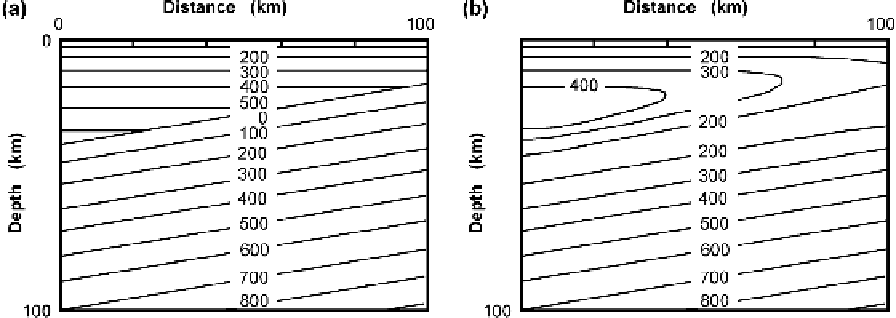Geoscience Reference
In-Depth Information
Figure 7.21.
(a) Overthrust-model initial temperatures. (b) The overthrust model
after 1 Ma of cooling. (From Fowler and Nisbet (1982).)
Overthrusts
Awholly different type of metamorphism is produced by overthrusts.
Figure 7.21(a) illustrates an example with a large overthrust slice of granite gneiss
material emplaced over mafic rock. Real parallels include subduction zones or
an area such as the eastern Alps, where a thick overthrust crystalline block has
produced metamorphism below it. In this simple model, thrusting is assumed to
be instantaneous. The most interesting feature of this model is that one thrusting
event necessarily leads to two very distinct metamorphic events:
1. very early and rapid
retrogression
(cooling) in the upper block and
progression
(heating)
beneath, followed by
2. slow progression (heating) throughout and finally partial melting and 'late' intrusion
to high levels.
Immediately after thrusting (Fig. 7.21(b)), the hot base of the overthrust block
thermally re-equilibrates with the cool underthrust rocks beneath. This initial
thermal re-equilibration is very rapid, and inverted thermal gradients are prob-
ably very short-lived. The resulting geotherm (temperature-depth curve) in the
thrust zone and below is of the order of a few degrees Celsius per kilometre.
If the cool lower slab is rich in volatiles, rapid retrograde metamorphism takes
place in the upper block. At the same time, equally rapid prograde high-pressure
metamorphism occurs in the lower slab. At the deeper end of the overthrust block,
local partial melting may take place if large amounts of volatiles move from the
lower slab into the hot crust of the upper block. This can produce shallow granitic
intrusions.
After this initial re-equilibration comes a long period (perhaps 30-50 Ma, or
more, depending on the size of the pile) in which a slow build-up of the geotherm,
which in reality would be affected by uplift and erosion, takes place. This is a

